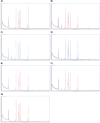Characterization of volatile profiles in cherry fruits: Integration of E-nose and HS-SPME-GC-MS
- PMID: 40547006
- PMCID: PMC12180960
- DOI: 10.1016/j.fochx.2025.102632
Characterization of volatile profiles in cherry fruits: Integration of E-nose and HS-SPME-GC-MS
Abstract
Aroma plays a crucial role in assessing the flavor quality of cherry fruits. This study compared the odor and volatile profiles of 37 cherry germplasm fruits using an electronic nose (E-nose) combined with headspace solid-phase microextraction-gas chromatography-mass spectrometry (HS-SPME-GC-MS). Notably, Cao5 exhibited a distinct odor compared to the other 36 sweet cherry cultivars. A total of 363 volatiles were identified and categorized into 14 classes. In terms of quantity, the top three categories of volatiles were terpenoids, esters, and alcohols. Among the samples, Saylor displayed the highest total volatile content at 76.98 μg∙g-1, whereas Minnie Royal had the lowest at 67.27 μg∙g-1. A total of 51 volatiles, including 1-nonen-3-one, 2-nonenal, (E)-, 2-nonenal, 2,4-nonadienal, and 2-hexenal, (E)-, were identified as the primary contributors to the aroma. In conclusion, this study aims to establish a foundation for rapidly and accurately evaluating cherry fruit flavor and developing new cultivars.
Keywords: Cherry; E-nose; HS-SPME-GC–MS; Relative odor activity value; Volatile compounds.
© 2025 The Authors. Published by Elsevier Ltd.
Conflict of interest statement
The authors declare that they have no known competing financial interests or personal relationships that could have appeared to influence the work reported in this paper.
Figures





Similar articles
-
Dynamic changes in volatile organic compounds of cherry tomato fruits during storage at different temperatures using HS-GC-IMS.Food Res Int. 2025 Oct;218:116790. doi: 10.1016/j.foodres.2025.116790. Epub 2025 Jun 12. Food Res Int. 2025. PMID: 40790653
-
HS-SPME/GC-MS and E-nose-based characterization of volatile compounds in purple garlic across eight Chinese regions.Food Chem X. 2025 Aug 7;30:102896. doi: 10.1016/j.fochx.2025.102896. eCollection 2025 Aug. Food Chem X. 2025. PMID: 40837091 Free PMC article.
-
Electronic nose, HS-GC-IMS, HS-SPME-GC-MS, and deep learning model were used to analyze and predict the changes and contents of VOCs in in-shell walnut kernels under different roasting conditions.Food Chem. 2025 Jun 26;492(Pt 1):145342. doi: 10.1016/j.foodchem.2025.145342. Online ahead of print. Food Chem. 2025. PMID: 40609363
-
The effectiveness and cost-effectiveness of carmustine implants and temozolomide for the treatment of newly diagnosed high-grade glioma: a systematic review and economic evaluation.Health Technol Assess. 2007 Nov;11(45):iii-iv, ix-221. doi: 10.3310/hta11450. Health Technol Assess. 2007. PMID: 17999840
-
Systemic pharmacological treatments for chronic plaque psoriasis: a network meta-analysis.Cochrane Database Syst Rev. 2021 Apr 19;4(4):CD011535. doi: 10.1002/14651858.CD011535.pub4. Cochrane Database Syst Rev. 2021. Update in: Cochrane Database Syst Rev. 2022 May 23;5:CD011535. doi: 10.1002/14651858.CD011535.pub5. PMID: 33871055 Free PMC article. Updated.
References
LinkOut - more resources
Full Text Sources
Miscellaneous

